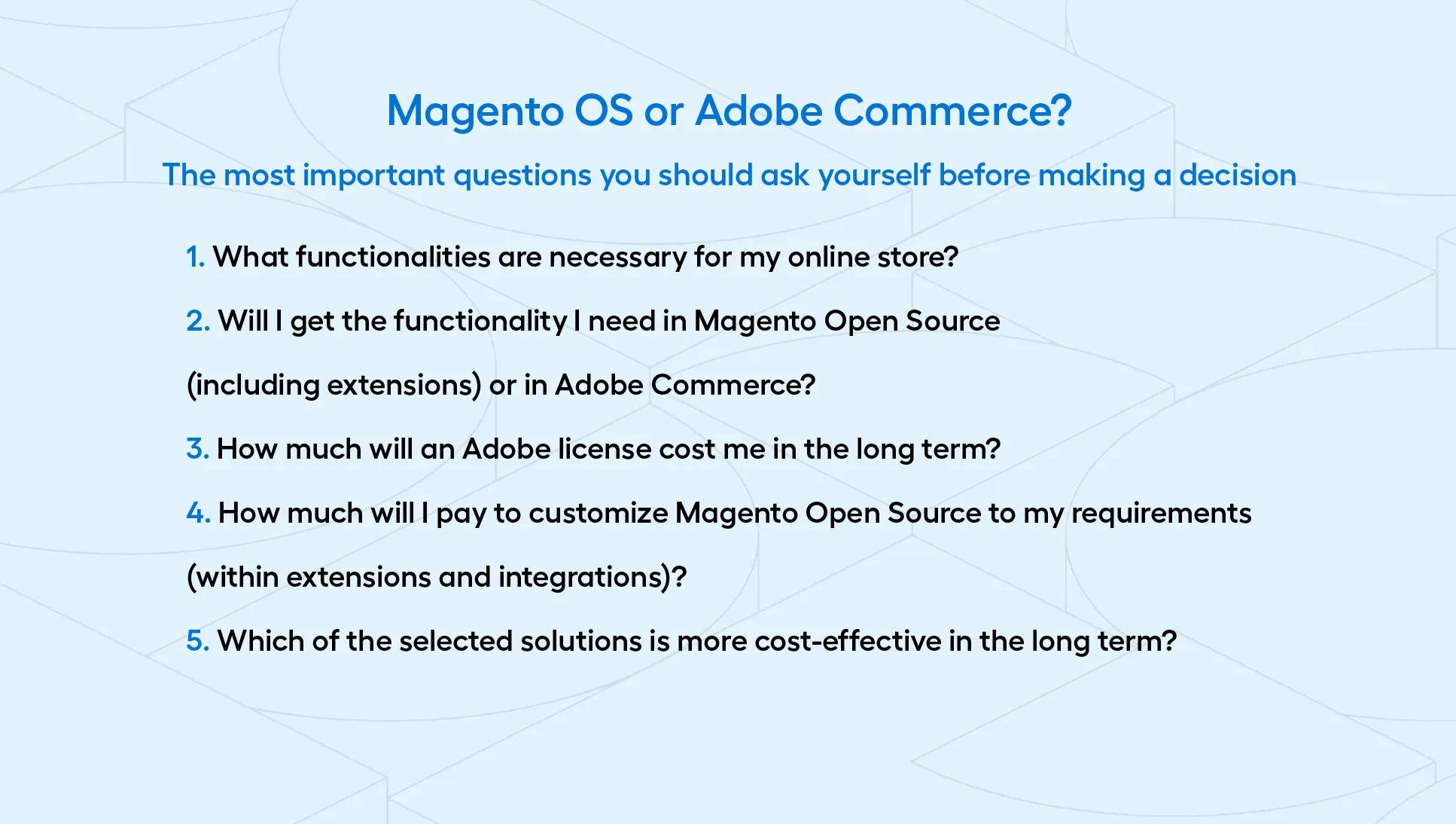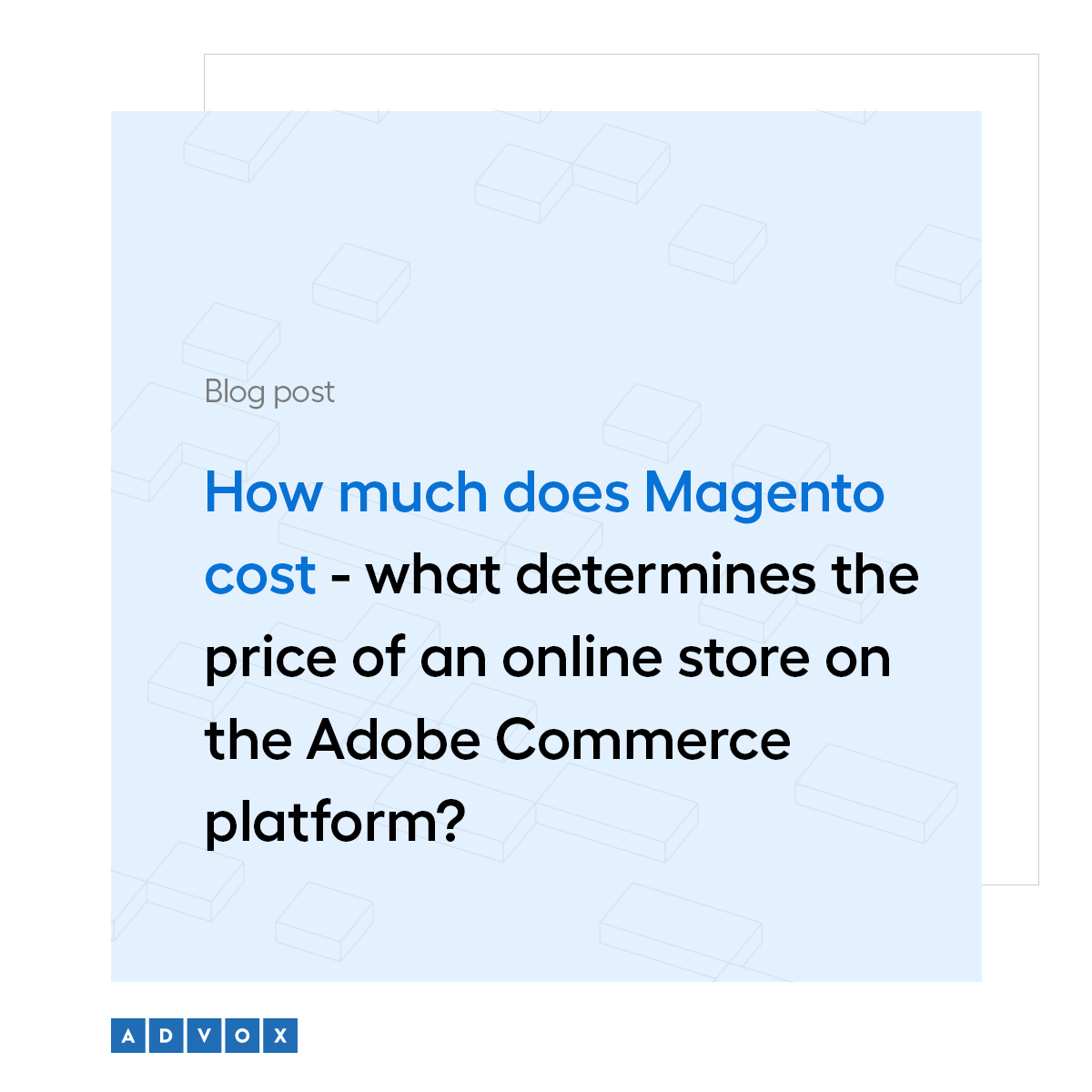Magento Open Source or Adobe Commerce - what are the functionalities of both versions?
When you make the decision to bulid your online store (whether from scratch or as part of a move or expansion) on Magento, you'll quickly discover that there are two versions to choose from: free Magento Open Source and paid Adobe Commerce. But before you start calculating how much a license will cost you ( under the belief that what you have to pay for is better than a free solution, right?), check out the differences between the two available options. Then you'll discover that it's not only financial matters that need to be taken into account when choosing, but also (or rather, first and foremost) the needs of your business.
Magento OS versus Adobe Commerce - what should you pay attention to?
We mentioned at the very beginning what the main difference between the Open Source version of Magento and Adobe Commerce manifests itself - the cost. While the first one is free, in the case of the second one, the fees start at around $22,000 per year, depending on the eCommerce turnover (the cost increases with the gross sales value). For this reason, it is very often pointed out that Magento OS will work better for start-up or medium-sized stores, while Adobe Commerce is a solution for large businesses with a wide product catalog. However, this statement should not be taken as an overriding rule - the choice should be guided primarily by the adopted development strategy and business perspective.
A free version of the software developed by a wide community of specialists (including those belonging to the newly founded Mage-OS association) or a paid version packed with a range of functionalities? To answer this question, extensive considerations should be made. It should start with the thought that it is not at all the case that choosing the open source version of a sales platform is a mistake, because "paid is always better than free." After all, everything should follow the needs of your business - they must be diagnosed first, so that later you can get acquainted with the characteristics of both versions and see which will be a better answer to them.
A summary of the most important features of Magento OS and Adobe Commerce that you must always keep in mind can be found in the table below. They provide a starting point for discussing which decision is best for your business.
| Magento Open Source | Adobe Commerce |
|---|---|
| free access | paid license |
| no cost of permanent use of the platform | cost of use depends on turnover (about $22,000 - $125,000 per year) |
| possibility to develop with the help of internal and external developers | more possibilities in terms of functionality already at the start |
| costs related to the implementation of additional modules, extensions and integrations | possible costs of further development |
| support from a wide community | Adobe technical support 24/7 |
| lack of possibility of cloud deployment | possibility of deployment in the cloud |
Magento Open Source - free version of sales platform
Will you build a simple eCommerce from scratch with all the necessary features for sales with the help of Magento Open Source? As much as possible, as built-in modules (identical to Adobe Commerce) include:
- integrated check-out,
- payment and shipping,
- WYSIWIG page builder,
- global sales,
- site search,
- instant purchase,
- mobile-optimized shopping,
- catalog management.
What's more, Magento Open Source provides access to a number of extensions within the Magento Marketplace - both free (to download and use right away) and paid (premium extensions allowing you to get a greater variety of features), as well as plug-ins from external suppliers (such as Aheadworks). Taking advantage of such opportunities is a way to increase the functionality of stores - according to the needs of a specific customer - in such areas as:
- customer service,
- marketing,
- content management,
- payment processing,
- security.
Also, don't forget that the software house you outsource the project to may decide to design the module itself as part of the best possible customization for your business.
Magento OS - what role does the community play?
The Open Source version of the platform is developed by specialists who support nearly 200,000 currently operating online stores on Magento (about 10% of all eCommerce sites worldwide). Developers make sure that the ecosystem responds to the needs of businesses from different industries, while solving any problems they face. They communicate mainly in English (more than 50% of the platform's eCommerce sites are located in the US), which makes it easier for foreign developers with high-level English skills to obtain information.
Moreover, the development of the platform is taken care of by companies around the world, constantly creating new solutions, which, after a testing period, are made available for public use or purchase. It should be noted that the open-source version is also not left without support from Adobe (although the area of support is limited). This is evidenced, for example, by the fact that last year (August 2021) with the release of Magento version 2.4.3. Page Builder (functionality for creating content using drag&drop) was implemented into open-source, providing a certain part of the experience previously reserved for Adobe Commerce (as of 2018).
Is Magento Open Source completely free of charge?
Just using Magento Open does not involve any licensing costs, but this "free" does not relieve from having to pay other costs, such as for setting up a server and hosting. Only after this step is completed can you start working on building your eCommerce.
In creating the design of your store, you can use ready-made Magento themes (so-called "themes"), which allow to transform the appearance of graphical interfaces in a customized way. Another option is to use themes from a third-party company or create one yourself from scratch by the software house you commission to design your eCommerce. In either situation, however, you'll have to reckon not only with the cost of set-up and development, but also themes and the additional modules, extensions or integrations we've already mentioned.
Adobe Commerce - a paid version of Magento for your business
Adobe Commerce has all the basic functionalities that characterize Magento Open Source, but their catalog extends widely beyond the free version. A special feature is the additional capabilities that characterize Page Builder, such as content preview, dynamic blocks or native integration with product recommendations, among others:
- advanced customer loyalty tools (award points, add products to cart by SKU, manage company accounts, purchases, quotes),
- functionalities created for B2B (from price negotiation, creating requisition lists, trade credits, accepting advance payments, to the ability to place orders quickly),
- extensive analysis features (including Google Analytics integration with Magento Data, generation of up to 100 types of different reports, financial data analysis),
- option to use virtual and digital products (such as subscriptions, gift cards, etc.),
- store credit function (refunding money to the customer's account),
- conducting customer segmentation.
The mentioned elements clearly indicate that Adobe Commerce is characterized by increased capabilities and will be great for online stores that know exactly what functionalities they would like to offer their customers. It is also worth mentioning that the paid version is continuously developed and supported by Adobe, and comes with a 24/7 technical support service guarantee.
Magento OS and Adobe Commerce - which solution for B2B businesses?
If you are running B2B business, you surely realize that the needs of your business customers require the implementation of specific functionalities that make making wholesale purchases fast, simple and seamless. This type of platform can be built on either Magento Open Source or Adobe Commerce.
There's no doubt that Adobe Commerce is the one with numerous capabilities to support business cooperation in areas such as price negotiation (requesting product pricing in the shopping cart), payment (accepting advance payments, trade credit), personalization of purchases (assigning catalogs and price lists according to contracts) or ordering (creating lists of frequently ordered products, creating lists of products to order later, quick ordering).
A summary of the functionalities created for B2B sales, and made available in Magento Open Source and Adobe Commerce, is shown in the table below.
| Functionalities for B2B | Magento Open Source | Adobe Commerce |
|---|---|---|
| Sales support | ||
| Marketing and promotion | ||
| Expanded product categories | ||
| Product filters | ||
| Product availability | ||
| Stock levels | ||
| Product search | ||
| Payments, deliveries, shipments | ||
| Partner structures (purchasing groups, consortiums) | ||
| Purchaser account | ||
| Purchase lists | ||
| Pending baskets | ||
| Request for quotation and offers | ||
| Handling authorizations |
Magento 2 - a solution tailored to your needs
Why should you choose Magento Open Source? Because this way you will avoid the relatively high licensing costs, and you will get an online store tailored to your needs by implementing additional extensions and integrations. However, you need to check what the final cost of customizing this version of one of the world's most popular eCommerce platforms will be. This is because it may turn out that the additional costs associated with both the purchase of the necessary modules and their implementation (proper configuration of advanced features carried out by the developers) will make the investment in Adobe Commerce more profitable from a business point of view.
This type of situation is most likely to occur when you are planning extensive business development and you will need the high flexibility and scalability of the platform. After all, it should be noted that there are some limitations of Magento OS in this regard - if your eCommerce starts to grow rapidly with new pages and storefronts, the platform on a free license may not be able to handle the load due to database limitations. As a result, the site may start to run slower, which will result in negative consequences for your business.

Magento OS or Adobe Commerce - which should you choose?
Which solution is better? Once again, as with many questions about the eCommerce industry, the answer is "it depends," so you really have to decide for yourself which of the available versions is right. How can you do this? Start by determining your needs in terms of functionality that the platform you choose must provide. Then compare the capabilities of Magento Open Source and Adobe Commerce in terms of receiving the necessary modules, checking which ones are built-in and which ones will have to be additionally designed or purchased. Finally, put together the calculations you made, which should show whether the open source or paid version is more cost-effective for you.
Remember that you don't have to be alone in this process - you can take advantage of the knowledge and experience of the selected software house, which will surely prepare an offer best suited to your needs. After all, the answer is not always: choose paid, it will certainly be better. As Advox, we have realized a number of projects for clients operating in various industries using the free version of Magento 2, and we have no doubt that for the eCommerce part it is the best solution. For the needs of many projects, the paid version of Magento will answer better at the very beginning.
Contact us and together we will pick the best solution for your business!







